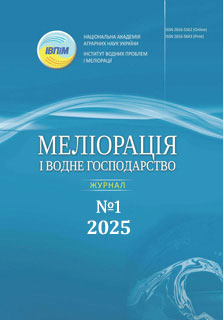CONCEPT OF INVOLVING GASES IN THE FORMATION OF THERMODYNAMIC AVAILABILITY OF PLANT NUTRIENTS AND THE COURSE OF SOIL PROCESSES
Abstract
The important role of gases in the planetary energy-mass exchange of the lithosphere with the atmosphere is determined, and attention is focused on the multifaceted mechanisms of gas exchange, especially under non-isothermal soil conditions. The conceptual principles of involving gases in ensuring the thermodynamic availability of plant nutrition, which emphasize the role of gases in a heterogeneous soil system, which is characterized by the presence of trapped air bubbles, are based on experimental data. Trapped soil air bubbles in the soil environment play the role of a distributed energy source when interacting with the thermodynamic parameters of the environment - temperature, atmospheric pressure and soil moisture content. The reaction of the soil capillary potential to a daily dynamics of external thermodynamic parameters has the nature of a self-oscillating process with a significant amplitude of the thermodynamic availability of the pore solution for plants.
This turns the trapped air bubbles into centers of thermodynamic disequilibrium (CTD), acid centers of a certain strength (AC) and ecotone centers of soil biota. Thermodynamic accessibility is determined by the dynamics of soil heterogeneity, i.e. its energy saturation with surface types of energy, as well as by increasing matter mobility and intertransitions of different categories of soil absorption capacity. The functional parameters of the soil are determined by the gas composition of the soil atmosphere, where a special role belongs to carbon dioxide (CO2), as the main factor in maintaining soil homeostasis. Emphasis is placed on the fact that under natural conditions of soil functioning, the composition of the smallest bubbles is enriched with oxygen and nitrogen, and most importantly, the size of these bubbles becomes close to nanoradii, which gives them abnormal properties.
Using the example of nanotechnologies with various gases, the possibility of targeted control of soil processes to increase the productivity and quality of plant products and ameliorative improvement of soils has been proven. The conclusion about the extremely high potential of integrating nanobubble technologies into ameliorative agriculture when using modern drip irrigation technologies has been made.
References
2. Vernadskyi, V.Y. (1944). O znachenyy pochvennoi atmosferu y ee byohennoi strukturu. [On the importance of the soil atmosphere and its biogenic structure]. Pochvovedenye, 4-5, 137-143 [in russian].
3. Romashchenko, M., Husyev, Y., Shatkovskyi, A., Saidak, R., Yatsyuk, M., Shevchenko, A., & Matiash, T. (2020). Vplyv suchasnykh klimatychnykh zmin na vodni resursy ta silskohospodarske vyrobnytstvo [Impact of climate change on water resources and agricultural production]. Melioratsiia i vodne hospodarstvo, 1, 5 – 22. doi: https://doi.org/10.31073/mivg202001-235 [in Ukrainian].
4. Mynko, O.Y. (1988). Planetarnaia hazovaia funktsyia pochvennoho pokrova [Planetary gas function of soil cover]. Pochvovedenye, 7, 59-75 [in russian].
5. Metody yssledovanyia hazovoi funktsyy pochvy (1987). [Methods of studying the gas function of soil]. Sovremennye fyzycheskye y khymycheskye metody yssledovanyia pochv: pod red. A.D. Voronyna y D.S. Orlova. Moskva : Yzd. MHU. 118-156. [in russian].
6. Lykov, A.V. (1950) Teoriia sushki [Theory of drying]. Moscow. Gosenergoizdat. 416 p. [in russian].
7. Kolomiiets, S.S., & Yasenchuk, O.V. (2014). Osoblyvosti protsesiv neizotermichnoho masoobminu v gruntakh i perspektyvy yikh vykorystannia v innovatsiinykh ahrotekhnolohiiakh [Peculiarities of non-isothermal mass transfer processes in soils and prospects for their use in innovative agricultural technologies]. Melioratsiia i vodne hospodarstvo, 101, 247-2591. [in Ukrainian].
8. Kolomiets, S.S., & Iatsyk, M.V. (2009). Sposib vyznachennia struktury porovoho prostoru gruntiv (dyspersnyh seredovyshch) [Method for determining the structure of porous space of soils (dispersed media)]. Patent of Ukraine. № 45287.. [in Ukrainian]
9. Romashchenko, M., & Kolomiiets, S. (2015). Dynamic model of soil functioning and development. Draft book of Abstracts. Soil Science in a Changing World. Wageningen Soil Conference. Wageningen, the Netherlands. R. 228.
10. Kolomiets, S.S. (2021). Termodynamichna systema gruntu, ioho homeostaz i virohidnyj mehanizm utvorennia struktury [Thermodynamic system of soil, its homeostasis and a probable mechanism of structure formation]. Visnyk agnarnoi nauky, 3, 14–22 [in Ukrainian].
11. Kolomiets, S.S. (1999). Ekolohichna harakterystyka gruntu [Ecologic characteristic of soil]. Visnyk agrarnoi nauky, 12, 9–13 [in Ukrainian].
12. Lower, S. (2022). Solutions of gaseous solutes in liquid solvents]. Simon Fraser University. Retrieved from: https://chem.libretexts.org/@go/page/78395
13. Chaurasia, G. (2023). Nanobubbles: an emerging science in nanotechnology. Journal of Medical Sciences, 10(2), 327-334. DOI: 10.4103/mgmj.MGMJ_59_23.
14. Bulavin, L.A., Kekishev, P., Sysoiev, V.M., & Sheiko, N.L. (2014). Mekhanizm vynyknennia nanobulbashok u vodi na hidrofobnii poverkhni [Mechanism of nanobubbles formation in water on a hydrophobic surface]. Ukrainskyi fizychnyi zhurnal, 59(1), 96-98. [in Ukrainian].
15. Arablousabet, Y., & Povilaitis, A. (2024). The Impact of Nanobubble Gases in Enhancing Soil Moisture, Nutrient Uptake Efficiency and Plant Growth: A Review. Water, 16(21), 3074. DOI: https://doi.org/10.3390/w16213074.
16. Bian, Q., Dong, Z., Zhao, Y., Feng, Y., Fu, Y., Wang, Z., Zhu, J., & Ma, L. (2025). Micro-nanobubble oxygenation irrigation enhances soil phosphorus availability and yield by altering soil bacterial community abundance and core microbial populations. Front Plant Science, 15:1497952. DOI: 10.3389/fpls.2024.1497952.
17. Ouyang, Z., Tian, J., Yan, X.,& Yang, Z., (2023). Micro-nano oxygenated irrigation improves the yield and quality of greenhouse cucumbers under-film drip irrigation. Scientific Reports, 13:19453. DOI: 10.1038/s41598-023-45121-3.
18. Zheng, Z., He, Y., He, Y., Zhan, J., Shi, C., Xu, Y., Wang, X., Wang, J., & Zhang, C. (2025). Micro-nano bubble water subsurface drip irrigation affects strawberry yield and quality by modulation of microbial communities. Agricultural Water Management, Vol. 307, 109228. DOI: https://doi.org/10.1016/j.agwat.2024.109228.


